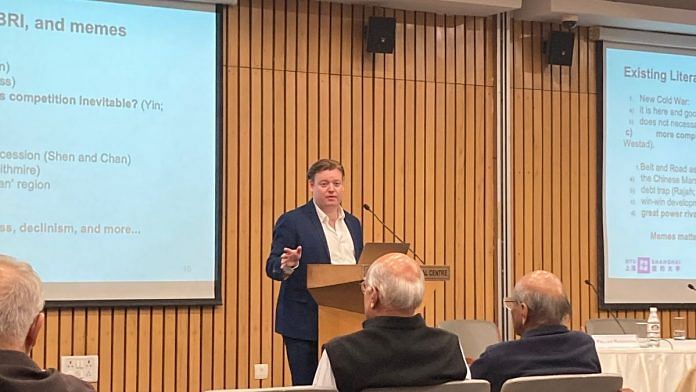New Delhi: Memes hold the key to understanding the fraught relationship between China and the United States as foreign policy analysts worry about the threat of a new Cold War according to Ivan W Rasmussen, an associate professor of practice in political science at NYU Shanghai. While analysts are scrutinising every statement coming out from Beijing and Washington; reading into the smiles, frowns and nods from presidents Joe Biden and Xi Jinping, he points to the rise in the term assertive China as a more accurate way to read the mood.
At a lecture, “Are we REALLY in a New Cold War? The Belt-Road, US-China Relations and Perceptions of a New Cold War”, on 16 November at New Delhi’s India International Centre, Rasmussen expanded on the traditional dictionary definition of memes as an amusing or interesting item widely spread on social media. He showed how memes surrounding China affect the perception of the country globally.
The word “assertive China” that keeps cropping up in headlines and news analysis is an example of a meme. Until 2010, the English media rarely used the word ‘assertive’ to describe China. But over the last decade, it has become more and more popular. So, headlines like ‘NATO may have to deal with a more assertive China in the far north’ and ‘World will witness an assertive China but Russia’s importance will wane…’ are common not just in international media, but in India as well. Even New Zealand Prime Minister Chris Hipkins spoke about ‘China’s assertiveness’ in the Pacific region.
“Memes are commonly shared beliefs or perceptions,” Rasmussen said before delving into the research by Harvard academic Alastair Iain Johnston and his study on the viral meme plaguing the American media. Published in 2013, Johnston’s study measured the number of times American media, blogs and academic papers referred to China as assertive.
In 2008, for example, less than 20 articles used the term “assertive” within five words of “China.” And in 2010, over 140 such articles were published, according to Johnston. Similarly, in the blogosphere, there were less than 100 blogs in 2008 that used the term “assertive China” while in 2010 there were nearly 700 such blogs according to Johnston’s paper.
Language matters. It can affect internal and public foreign policy debates especially when the echoes of a new Cold War are growing louder.
Also read: How social media memes became a political weapon to woo first-time voters
Facets of a Cold War
Rasmussen compared the relationship between the US and China to a marriage – one currently going through a messy divorce. For over four decades, both countries have seen close economic cooperation. Beijing was the home for manufacturing a lot of American technologies. It won’t be a clean or easy split.
Rasmussen also dismissed the facet of differing ideologies, which were a key in disrupting Russia-US ties in the decades up to 1991 when the Cold War finally ended.
The original Cold War was easier to grasp. There were clear delineated sides—the North Atlantic Treaty Organisation (NATO) and the Warsaw Treaty Organisation (Warsaw Pact). The two organisations were collective security organisations with a mutual defence clause pledging to defend each other in the event that one or more members came under attack.
And while the two ‘superpowers’ did not directly face each other, proxy conflicts were fought across the world—by countries allied with one side or the other. Rasmussen highlighted proxy conflicts such as the Korean War (1950-1953), Vietnam (1955-1975) and Afghanistan (1979-1989).
But a member of the audience was not convinced.
“The old Cold War led to 1,200 deaths a day in Asia. It was fought here, so while it may have been a Cold War for the rest of the world, for this continent it certainly was not,” he said.
In today’s global world, the lines are a lot more blurred. Economic divisions and technological divides are no longer clear-cut.
“Economic decoupling is simply impossible in the current situation,” Rasmussen said.
He then brought up another intriguing portion—whether allies of the US would be willing to join Chinese-led international institutions, should there be a Cold War between the two superpowers.
Also read: A Pakistani friendship meme broke the internet. Now it makes a new record
Chinese-led international institutions
Rasmussen used the example of the Asian Infrastructure Investment Bank (AIIB), a multilateral development bank (MDB) founded in 2016 as an example of a potential new international institution founded by China.
“The Asian Infrastructure Investment Bank is a potential institution of a new international order. It is an institution that I am using as an example because it is measurable to see who joined the AIIB. Till 2016, US allies had no issues joining Chinese-led institutions,” Rasmussen said.
He showcased how through his research, of the 57 founding members of the bank, a large number of them were allies of the US and even NATO members like Germany, France, Australia, Luxembourg, Israel and Canada to name a few.
“Look at the flags of the founding members of the AIIB. You will find a lot of countries you recognise as US allies, geographically across the world as well as high-income countries,” Rasmussen said.
The notable exceptions however were Japan—which has a large role to play in the Asian Development Bank (ADB) and the US itself.
Rasmussen conceded that while the data shows there may be a potential for a new Cold War, there does not seem to be one ongoing at the time. But the power of perception and rhetoric matter in policy making.
“If you start to think like it is a Cold War, then you are going to act like it is real and this could lead to policymakers making policy mistakes,” Rasmussen said.
(Edited Theres Sudeep)



